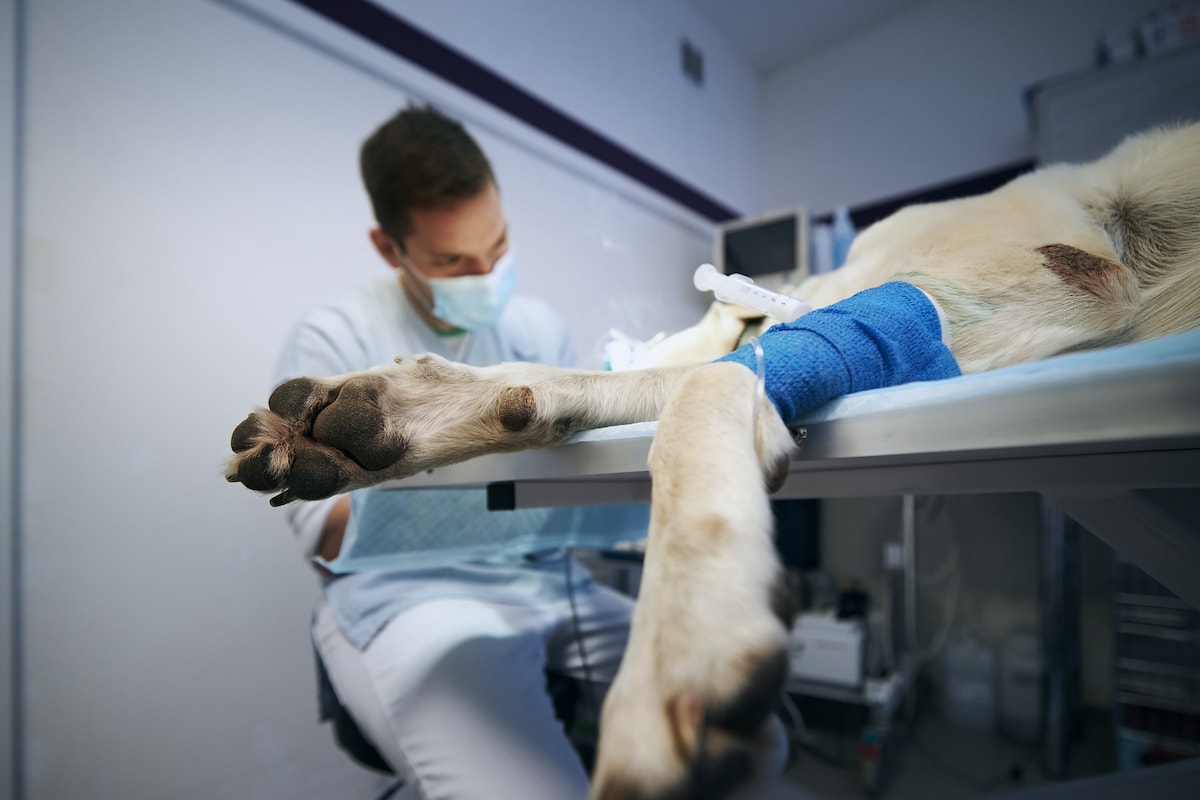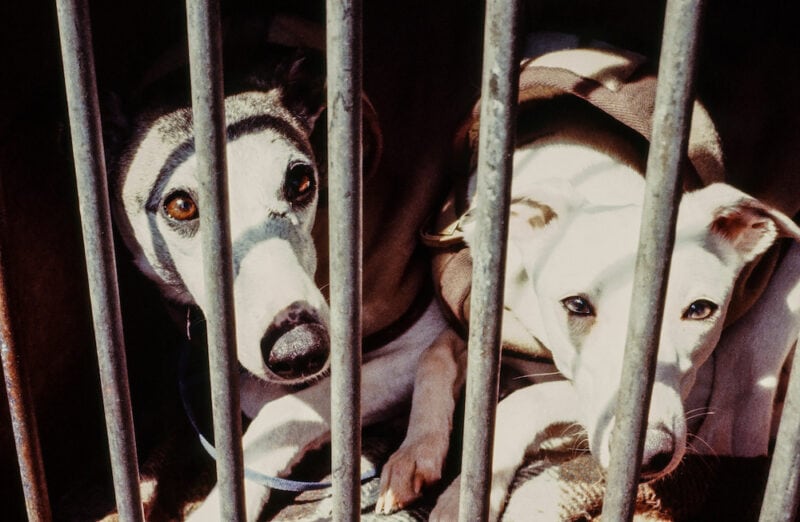Spaying and neutering is essential for maintaining our pet’s health — but it does much more than that! It also can help mediate behavior issues, help your pet live longer, and is tremendously important for helping to combat the pet overpopulation crisis.
General Spay & Neuter Facts
One female dog and her offspring can produce 67,000 puppies in just six years!
Source: PETA
One unspayed female dog and her initial litter can lead to 67,000 puppies in just six years. And for cats, it’s even more staggering, with one female cat and her offspring able to produce a whopping 370,000 kittens in seven years!
These figures really bring home the scale of the pet overpopulation problem and underscore why spaying and neutering are so crucial. They’re not just about preventing unwanted litters, but they’re also about breaking this potential cycle of exponential population growth.
93% of cats are neutered in families with a household income of $35,000 or more, compared to 51% of cats in households earning less than $35,000.
Source: The Journal of the American Veterinary Association
With family income as the strongest predictor of whether house cats are neutered, it’s clear that cost could be a major barrier for many families. This highlights the importance of affordable and accessible spay/neuter services, especially for lower-income households.
Without them, not only do we risk more unwanted kittens, but we may also be inadvertently contributing to larger socioeconomic inequalities in pet ownership and care.
Some cities have had great success targeting free spay and neuter campaigns in specific zip codes.
Source: White (2010)
Austin, Texas in particular had great success from launching a program in 2000 that offered free spay/neuter services in seven selected zip codes, specifically targeting areas with lower income and higher poverty levels.
Interestingly, these areas weren’t chosen based on shelter intake but have still shown positive effects.
When comparing these areas with the rest of the city, there was a slower increase in the number of animals taken into shelters over time. This shows that targeting spay/neuter efforts in specific areas can really help control shelter intake numbers for both cats and dogs.
This gives us some food for thought.
Maybe focusing spay/neuter efforts on certain areas, particularly those that might struggle with the cost, could be a practical strategy in tackling the broader issue of pet overpopulation. It’s certainly worth considering as part of a multi-pronged approach.
Voluntary sterilization is the only known method documented of significantly reducing the animal shelter population.
Source: ASPA
According to the ASPCA, the only known and documented humane method that’s demonstrated a correlation with long-term efficacy in significantly reducing the number of animals entering shelters is voluntary sterilization of owned pets. It’s our best and most powerful method of solving the pet overpopulation crisis.
The veterinary community has even formally acknowledged that safe, efficient sterilization is the “best antidote to the mass euthanasia of cats and dogs resulting from overpopulation” (Looney 2008).
Health Benefits of Spay & Neutering
Female pets who are spayed life a longer, happier life.
Source: ASPCA
Spaying not only increases your female pet’s lifespan, but also promotes overall health. Spaying prevents uterine infections and reduces the risk of breast tumors (which can be malignant in roughly 50% of dogs and 90% of cats).
Certain types of cancer and infections like pyometra can be avoided with spay and neutering.
Source: Humane Society International
There are a number of potentially fatal transmissible diseases and health conditions that pets can develop due to being intact and breeding. Examples include pyometra, reproductive cancers, and transmissible venereal tumor (TVT).
Dogs who are spayed and neutered on average live an additional 1-3 years.
Source: Humane Society International
It’s estimated that dogs who are spayed and neutered live an additional 1-3 years more than their intact counterparts.
A University of Georgia study, confirmed this with a study based on the medical records of more than 70,000 animal patients. In their researchthey found that the life expectancy of neutered male dogs was 13.8% longer and that of spayed female dogs was 26.3% longer.
Another study, conducted by Banfield Pet Hospitals, examined a database of 2.2 million dogs and 460,000 cats with similar findings — they found that neutered male dogs lived 18% longer and spayed female dogs lived 23% longer. Spayed female cats in the study lived 39% longer and neutered male cats lived 62% longer.
A few studies have suggested spaying and neutering dogs can predispose some to orthopedic issues or certain cancers – but this is only true for giant breeds.
Source: Humane Society of America
While a few studies might raise concerns about the potential health risks of spaying/neutering, it’s essential to understand the specifics.
These studies focus particularly on male dogs of certain giant breeds, typically those weighing 90-100 pounds or more, suggesting these surgeries might increase their risk of certain orthopedic conditions and cancers.
However, it’s crucial for pet owners to know that these findings are not applicable to all dogs, let alone other species like cats. It’s not a one-size-fits-all situation.
So while it’s normal to have concerns, for the vast majority of pets, the benefits of spaying/neutering—like preventing overpopulation, reducing aggressive behavior, and avoiding various health issues—still far outweigh any potential risks.
It’s always best to have a chat with your vet to figure out the right approach for your furry friend!
Additionally, the studies have only found an association between cause and outcome – they have not established any true causality.
Even when a study finds results that are statistically significant, this does not always indicate a clinically significant difference. We need more repeatable prospective studies done by a variety of researchers in various geographic locations with larger sample sizes to really determine if spaying and neutering poses any kind of risk for giant dog breeds.
Caring for a pet with reproductive cancer can cost 5-10x more than a routine spay or neuter surgery.
Source: Humane Society of America
Treating a pet with reproductive system cancer or pyometra can run into thousands of dollars, which is significantly more expensive than routine spay or neuter surgery. We’re talking five to ten times the cost!
Not only can spaying/neutering save pet owners from potential financial stress down the line, but it also spares the pets from going through these serious health issues. So, it’s not just about population control and behavior, it’s also a financially sensible decision for most pet owners.
After a dog’s second heat cycle their risk of developing mammary cancer jumps to 25%
Source: Animal Health Foundation
The principal benefit of spaying female dogs and cats is the prevention of mammary cancer.
Research has found that a dog spayed before her first heat will have a near zero chance of developing mammary cancer as she ages.
After a dog’s first heat cycle, this incidence climbs to 7%, and after the second heat, the risk nears 25%. Statistics are similar in cats.
Spaying prevents 100% of uterine and ovarian cancer risk in dogs.
Source: Animal Health Foundation
Less common conditions such as uterine and ovarian cancer are 100% prevented by spaying.
When to Spay or Neuter
Dogs are traditionally neutered at 6-9 months.
Source: ASPCA
Dogs can also be neutered when they’re older, but there tends to be a slightly higher risk of post-operative issues in older dogs or those that are overweight. While six to nine months is the general neutering age, healthy puppies can be neutered as early as 8 weeks old.
It’s suggested that you spay your cat before 5 months of age.
Source: ASPCA
Spaying before five months can help you potentially circumvent the beginning of any spraying issues and reduce any risk of pregnancy. However, kittens can be safely spayed or neutered as early as eight weeks. And – against popular belief – you can spay a cat who is in heat.
Spay & Neuter’s Affect on Behavior Issues
Intact (unneutered) male dogs represented 90% of dogs brought to veterinary behaviorists for dominance aggression and account for 70%-76% of all reported bites.
Source: AVMA
Wow – clearly unneutered, male dogs are significantly overrepresented when it comes to certain behavioral issues. Intact males account for 90% of dogs presented to veterinary behaviorists for dominance aggression (the most commonly diagnosed type of aggression).
Unneutered male dogs are also involved in 70%-76% of reported dog bite incidents. That correlation is hard to ignore!
Spayed cats won’t urine or yowl as much.
Source: ASPCA
Spayed cats won’t go into heat – which can be quite the plus since they’ll often yowl and urinate more often (sometimes all over the home) in order to attract mates.
Neutered dogs are less likely to roam away from home.
Source: ASPCA
Intact male dogs can become obsessed with finding a female to mate with, and will often find any number of ingenious ways to escape the house. Once he escapes, a dog can easily get hurt in traffic or get into fights with other animals.
Neutering your male dog could lead to improved behavior.
Source: ASPCA
Male dogs and cats that are not neutered often exhibit territorial behaviors, such as marking their surroundings with potent-smelling urine. Post-neutering, your dog may exhibit less mounting behavior towards other dogs, people, and inanimate objects (a freshly-humped pillow doesn’t tend to look too inviting when you want to lounge on the couch).
Neutering early can even prevent certain aggression-related issues right from the start
Spaying/neutering your pets will save you money.
The cost of a pet’s spay/neuter surgery is much less expensive than the cost of having and caring for a litter of young animals.
Neutering is not a quick fix for all behavior issues.
Source: ASPCA
While neutering often reduces undesirable behaviors that can be caused by a higher level of testosterone, there is no guarantee that your dog’s behavior will improve after neutering.
While it reduces testosterone, it doesn’t eliminate the hormone completely. Neutering also won’t do much to fix behaviors that your pet has learned or that have become habitual. Many effects of neutering can depend on your dog’s individual personality and physiology.
COVID-19’s Effects on Spay & Neuter Numbers
Decreased spay and neuter rates during the COVID-19 pandemic has resulted in a tremendous overcrowding issue in shelters across the country that still hasn’t been corrected.
In 2020 and 2021, U.S. veterinarians performed 2.7 million fewer spay and neuters than usual.
Source: Guerios (2022)
With so many animals intact and able to reproduce, overpopulation in animal shelters has become a major issue across the country. Many shelters began facing an all-out crisis in 2022 and 2023, contributing to rising euthanasia rates.
Spay and neuter surgeries helped reduce the number of euthanized shelter pets from 13.5 million in 1973 to 1.5 million in 2009
Source: Guerios (2022)
It’s remarkable to see just how much of an impact spay and neuter procedures have made on animal shelters over the past 40 years. In 1973, a staggering 13.5 million animals had to be euthanized due to pet over-population, but by 2009, this figure had plummeted to 1.5 million. That’s a massive reduction!
Compared to 2019, total surgeries decreased 13% to 1,059,388 in 2020 and decreased 3% to 1,184,274 in 2021.
Source: Guerios (2022)
Comparing the numbers, total surgeries saw a decrease of 13% in 2020, down to 1,059,388, probably due to restrictions and lockdowns making it harder to access vet services during the height of the COVID-19 pandemic. In 2021, there was a further slight decrease of 3% with 1,184,274 surgeries performed.
This is a dramatic decrease in spay and neuter surgeries, and it’s had a tremendous impact, starting a pet overpopulation crisis that continues to be a major issue.
Compared with 2019, in 2020 surgeries decreased 17% in the Midwest region, 15% in the Northeast and West, and 11% in the South. Surgeries were reduced 19% in dogs and 10% in cats.
Source: Guerios (2022)
In 2020, compared to 2019, the Midwest saw the largest drop in surgeries with a 17% decrease, followed closely by the Northeast and West each with a 15% reduction. The South experienced an 11% decline. When looking at the numbers by species, surgeries in dogs decreased more significantly by 19%, while cats saw a 10% decrease.
This shows us the differential impact across different regions and pet species, probably influenced by factors like varying COVID-19 restrictions, availability of vet services, and even the distribution of pet populations. It highlights the need for flexibility and adaptability in our approach to pet population control, as the challenges aren’t the same everywhere.
Despite these decreases, we’ve seen before that efforts in spay and neuter surgeries can make a big difference, so it’s essential to rebound from this setback and keep striving for improvement.
The euthanasia rate for shelter dogs jumped from 5.2% to 7.4% in 2022 compared to 2021
Source: Animal Shelters Count
According to Shelter Animals Count, dogs saw a significant increase in shelter euthanasia rates, from 5.2% in 2021 to 7.4% in 2022. Despite this increase, it’s still lower than the 8% euthanasia from 2019.
Meanwhile, the euthanasia rate for cats remained stable at 7.1% for the first half of 2022, mirroring the rate of 2021. .
Lack of spay and neutering results in overcrowded shelters and burnt out shelter staff.
Overcrowding in shelters is a tough situation both for the animals and the people working there. For many pets, the noisy, tense environment of a packed shelter can be pretty overwhelming. And in shelters that aren’t committed to a no-kill policy, euthanasia can sadly become a common outcome for some of these animals.
When shelters get too crowded and staff can’t keep up, it unfortunately leaves more stray animals out on the streets. These animals face increased risks of harm or even death. It’s a tough cycle.
But this just underscores the importance of spaying and neutering pets. By controlling the pet population, we can help prevent shelter overcrowding and create better outcomes for these animals.
The UF College of Veterinary Medicine is responding to shelter overcrowding by increasing class size and updating its surgical training facility.
Source: University of Florida College of Veterinary Medicine
Seeing the darkening clouds on the horizon as shelters continue to struggle with pet overpopulation, the University of Florida’s College of Veterinary Medicine is increasing class sizes and remodeling its surgical training facility to better help students develop critical surgical skills, like spay and neutering.

Mandatory Spay & Neuter Laws
Mandatory and enforced spay and neuter laws could help.
Several cities and counties across the US are taking a stand against animal overpopulation by introducing mandatory spay-and-neuter laws, with a significant breeder’s fee for those who opt not to comply.
Many see it as a firm but fair approach, hitting right at the heart of the problem.
The best part is, these measures are showing results. According to research from PETA, areas with such laws in place have reported substantial reductions in the number of animals entering shelters and, crucially, in the number of animals being euthanized.
On the other hand, mandated spay and neutering runs the risk of potentially increasing shelter intake.
While some communities have found great success with spay and neutering, there are some potential downsides too.
Mandating spay and neuter runs the risk for a number of unintended side effects. If the costs of these procedures are too high for some pet owners, it might actually lead to an increase in shelter intake or prevent lost pets from being returned to their owners, with owners who can’t afford the procedure being unable to keep their pet, for fear of a fine.
Additionally, determining whether an animal, especially a female, has been spayed or neutered can be incredibly challenging even for a trained vet, let alone an animal control officer in the field.
The variation in law enforcement funding and personnel support across different communities adds another layer of complexity, leading to inconsistent enforcement of mandatory spay and neuter (MSN) laws.
This makes it really tough to compare the impact of these laws across different areas or to make accurate predictions about their effects.
MSN laws may have positive effects on one aspect of animal welfare, while having negative effects on another.
For example, in one community that enacted an MSN law, fewer pets were subsequently licensed, likely due to owners’ reluctance to pay either the high fee for keeping an unaltered animal or the fee to have the pet altered. (Office of Legislative Oversight, 1997)
Additionally, simply making spay and neuter mandatory doesn’t address the key barrier for many pet owners: access to affordable spay and neuter services. The cost of these surgeries is often the primary obstacle, especially in low-income communities.
Research has shown a strong association between low household income and having an intact cat, relinquishing pets to shelters, and shelter intake. In areas with high poverty levels, more pets are entering shelters and they face a higher risk of euthanasia.
This clearly highlights the need for a more holistic approach to pet population management. While MSN laws may be able to take a pivot role, they need to be part of a broader strategy that includes improving access to affordable spay and neuter services, particularly in under-resourced communities.
The issue is complex and interconnected with broader socio-economic factors, so our solutions need to reflect that.
Sources:
- https://www.animalhealthfoundation.org/blog/2012/06/how-spaying-and-neutering-benefits-pets-health-and-behavior
- https://www.aspca.org/about-us/aspca-policy-and-position-statements/position-statement-mandatory-spayneuter-laws
- White, Sara C et al. “Impact of publicly sponsored neutering programs on animal population dynamics at animal shelters: the New Hampshire and Austin experiences.” Journal of applied animal welfare science : JAAWS vol. 13,3 (2010): 191-212. doi:10.1080/10888700903579903
- https://www.avma.org/advocacy/state-local-issues/community-approach-dog-bite-prevention-abstract
- https://pubmed.ncbi.nlm.nih.gov/19366332/
- Office of Legislative Oversight, OLO Report 97-3: An evaluation of Bill 54-91, Revisions to the county’s animal control law. June 24, 1997. Montgomery County, MD.
- The Foundation for Interdisciplinary Research and Education Promoting Animal Welfare (FIREPAW). 2004. Cross-program statistical analysis of Maddie’s Fund programs, Williamstown, MA.
- https://doi.org/10.1371/journal.pone.0061082
- https://www.humanesociety.org/resources/why-you-should-spayneuter-your-pet
- https://www.vetmed.ufl.edu/2022/09/13/decrease-in-spay-neuter-surgeries-during-pandemic-may-undermine-pet-welfare/
- https://www.frontiersin.org/articles/10.3389/fvets.2022.912893/full
- https://www.shelteranimalscount.org/wp-content/uploads/2022/07/SAC_Q22022Report_R072822.pdf
- https://www.aspca.org/pet-care/general-pet-care/spayneuter-your-pet
- https://www.hsi.org/news-resources/why_spayneuter_important/








Leave a Comment